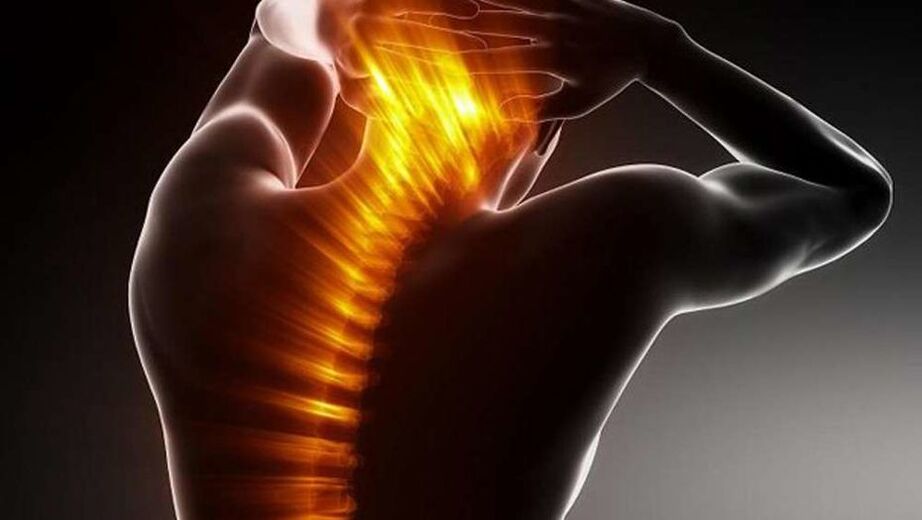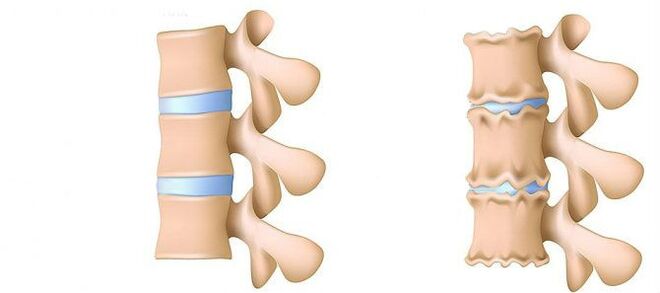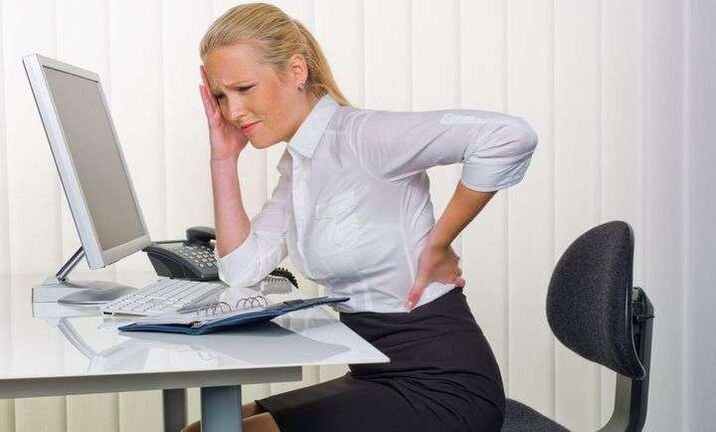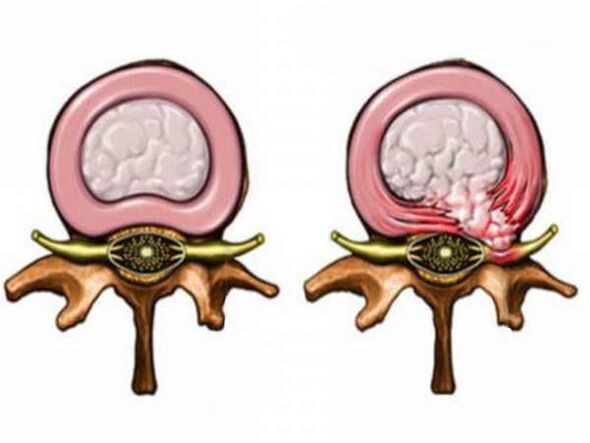Protection, hernias, osteochondrosis: when they are diagnosed, patients immediately rush the surgeon without considering conservative treatment methods, but this is wrong.

According to statistics, 84% of people at least once in their lives hurt.The spine and the surrounding muscles are part of the musculoskeletal system.Consequently, its damage is often accompanied by pain, which can occur after the trends or turns of the head and body and weakens at rest.Anatomically, the column is represented by alternate vertebrae and intervertebral discs.The latter over time are subject to the degeneration process, which leads to the formation of bumps and hernias.These structures can cause pain and can cause pain by compressing neighboring structures: nerve roots and spine ligaments.In some cases, they can cause stenosis (narrowing) of the spinal channel (space in which the spinal cord is located).
Among other things, the vertebrae are connected by peer facial joints, the structure is more rigid than the intervertebral disc.Its damage in 15-65% of cases causes back pain.Up to 30% of low back pain is due to the lesion of the sacral and illegal joint, an related structure that connects the sacrum and the bones of the pelvis.Ultimately, any irritation increases the tone of the muscles, which eventually causes a separate myofascial syndrome.
As a general rule, physical activity leads to back pain, especially in cases where it is expressed or intense, or when it occurs in an unnatural pose, or when it is associated with a long stay in a forced position, for example, behind the wheel of a car or on a desk.The body's body weight and training are of great importance, since the severity of the load is always relative.
What are the reasons for its development?
It is impossible to call unequivocally the causes of the development of osteochondrosis, but a series of factors that contribute to the appearance of this disease can be indicated: a poor physical development, a violation of metabolism in the body, genetic predisposition, inadequate posture, prolonged permanence in a pose (for example, before the computer monitor), the hypodlamia and the bed in excess, the flat bed, the flat bed.As a general rule, these reasons are combined with irrational nutrition.
What to do if there is back pain?
The most important rule is not to self -medicate!
Initially, it is necessary to reach an appointment with a neurologist or neurosurgeon.To establish a precise diagnosis, a comprehensive examination of the patient is necessary, which necessarily includes the radiography of the spine and the tomography (magnetic resonance or X -rays calculated. The purpose of this study must only perform the doctor based on a specific clinical image.
Drug care of the spine osteochondrosis includes not only the elimination of pain syndrome, but also, if possible, the elimination of the causes of the root.The doctor prescribes complex therapy (pharmacological therapy, physiotherapy, acupuncture, balneotherapy)
Complex therapeutic care for osteochondrosis includes power and lifestyle correction (healthy and active lifestyle, the optimal volume of physical education), purpose, in some cases: condroprotective medications that improve the condition of the cartilage tissue.
The main indication for surgical treatment for degenerative-dystophical spinal disease is the inefficiency of conservative pharmacological therapy for 4-6 weeks, unconscious of pain, as well as the increase in weakness in the legs, which in several cases can be accompanied by urinary incontinence.Inopportune and inappropriate treatment in such situations can lead to a series of undesirable consequences and complications, to disability.
Back pain are recognized as the most common.Experts explain this to the characteristics of human anatomy.The point is that the column is subject to loads throughout the life of a person: from the moment he stands in childhood until his death.The spine wears out, and late or subsequent problems arise in almost all.The most common diagnoses that are made with back pain: "Osteochondrosis" and "Radiculita", while patients often put them and prescribe the treatment themselves, without looking for advice for doctors.However, even for these diagnoses, which, apparently, are all listening, there are often reasons why only an experienced specialist can determine.
What hurts there?
In the vast majority (about 95%), pain is associated with muscles, ligaments and joints.People are called to remove their backs.These pains are unpleasant, but not hydrate and in most cases they pass on their own in 2-3 days.
3-4% of the pains are associated with radiculopathy (radiculitis) - damage to the spinal root.It is usually damaged by a hernia.The pains disappear when the edema that arose due to compression passes.
1-2% of back pain is caused with inflammatory lesions or diseases of the spine, oncological processes, cardiovascular system diseases or the gastrointestinal tract, in which pain syndrome can enter the back.This is the most dangerous type of back pain.To exclude such pathologies, be sure to consult a doctor.
You can't delay
The main indicator that needs medical attention is the regularity of pain.If it is twisted from time to time, it is most likely that there is nothing wrong.If the pain of low or medium intensity pursues you without rest, you cannot doubt.It is urgent to consult a doctor if the pain is accompanied by a temperature increase or pain grows in a treatment context.
Types of pain
Doctors distinguish 3 types of pain, which are often felt on the back.The doctor's task is to determine with precision what kind of pain the patient is concerned about the patient who contacted him, because each of them will be treated exclusively in his own way.
Nociceptive painOr, more simply, pain in receptors, skin, muscles, ligaments, joints, is considered the most common.The reasons that cause it in X -rays or in the use of computerized tomography are generally not visible.In this case, the specialist makes the diagnosis based on the symptoms of the patient.The causes of muscle spasm can be, for example, physical activity, when a person raised something heavy, he leaned abruptly or a temperature difference (a common air conditioning of example of an example).This type of pain is treated with two types of medications.
Acute pains are treated with analgesics of anti -inflammatory drugs and medications that relax the muscles.In this case, there can be no other therapy.When pain syndrome is eliminated, we recommend that the patient strengthen the muscles with physical education.This is the treatment and prevention of the disease for the future.
Physical exercises not only help strengthen muscles, but also contribute to the production of endorphins, as well as serotonin and norepinephrine in the body.These substances increase a person's pain threshold and eliminate depressive mood.
Neuropathic painOr nerve pain, people are better known as radiculitis.This type of pain in humans occurs, in particular, when vertebral hernia becomes large and squeezes nerve endings.At the same time, experts warn patients and the entire professional community against inappropriate diagnosis in cases where radiography and the use of MRI turns out that hernia or any other type of spinal wear is available, but it is not so significant to affect the nerve.It is necessary to carefully understand the true cause of pain.It is possible that a muscle spasm is guilty, and this type of pain is completely different, and the treatment will also differ for him.What is considered osteochondrosis not only is not manifested by pain, but also the norm.

Osteochondrosis is a sign of body aging.But "osteochondrosis" and "pain" are not the same.Since there are practically no nerve endings in bone tissue, protuberance (the initial stage of the intervertebral disco. - Auth.) Or a hernia cannot hurt.Even studies were conducted: Magnetic resonances were held groups of people: they chose, mainly those who had never approached a doctor with complaints about back pain, but found hernia and osteochondrosis.
In addition, the doctor gives examples when patients received treatment, and took place, despite the fact that osteochondrosis remained in the image.Osteochondrosis today is a concept that is used locally.
There are countries where the word "osteochondrosis" is not used.Last year, they officially said that this diagnosis was made by past generation neurologists.Abroad, when the patient reaches the reception and says that he hurts his back, they diagnose nonspecific pain on his back, but it is understood that a person gave a burden on the muscles.
Confirmation that pain is caused precisely by radicalis, and not with spasm, for specialists, the symptom in the form of pain in the back of the back, which give the nerve in the leg, it is more frequently for specialists.
The cause of nervous pain can also be complications caused by diabetes and herpes.In diabetes mellitus, patients often complain of pain, since this disease damages the nervous system.Postherpetic neuralgia is characterized by eruption strips along the damaged nerve and, consequently, pain.There are special drugs for the treatment of nervous pain.
For the treatment of neuropathic pain, anti -epileptics and antidepressants are used.I must say that the name of the drugs of this orientation of the patients scares, so it is important that they explain that it is the antidepressants that increase the threshold of pain.These are pain treatment standards.
Psychogenic painor chronic.This type of pain is not caused by physical changes in the human body, its mental state changes.Symptoms torment the patient in this case for a long time.At the same time, it hurts, as a rule, not just the back.
It happens that people come and say all my head, constantly.Questions: something heavy?No!And there is no clear location.In this case, we can conclude that the patient has reduced the threshold of pain and a pain analyzer, which is in the brain, is made constantly felt.It can cause pain in such a patient: excess work, stress, a feeling of fear.

Anesthetic drugs in this case will not help.Specialists generally recipe antidepressants, physical education to patients with chronic pain, but sometimes it is enough to find a reason using a psychologist or psychiatrist.
A young woman who complained about back pain: six months, she says, was tormented.I recommended that you go to a psychologist and physical education.A few days later he was completely healthy without taking any medication.The psychologist helped her understand that the cause of stress pain: she had family problems, physical education helped relax.
At homeThe most effective remedy is anti -inflammatory oral drugs.Simply not exaggerate, they are safe only for the first time.With prolonged use, such medications can cause ulcers and bleeding in the gastric mucosa.Traditional home treatment, non -steroid ointments, can only be used as an additional measure.They are harmless, but ineffective.Carsset also offers relief: the fixation downloads the column, relieves spasms and limits acute movements.Only the corset must be ordinary: elastic, not to heat up.
If the treatment has no effect for three days, you should consult a doctor who will block anti -inflammatory injections.Due to the elimination of spasms and the relaxation of the muscles, the pain is left immediately and often forever.
Forbidden!
Bathroom and massage under the strict ban.Edema and pain improve.
Manual contact therapists in the newspaper.Manual therapy is the area where each specialist represents three hundred charlatans.If you really want to find a good doctor, you must communicate with certified clinics where postgraduate specialists work.
It is important to correctly determine the tactics of the treatment.This must be done by a neurologist or neurosurgeon.It is dangerous to treat your back yourself.30% of the patients of the neurosurgical department tested home treatment methods and this took a hospital bed.
When the pills do not help
If the pharmacological treatment prescribes a therapist or a neuropathologist does not give results within 3-6 months and the pain continues to torment the patient, the doctor is obliged to transmit the patient to another specialist.In some situations, physiotherapy can provide significant assistance.It is suitable for the first two types of pain: in receptors and nerves.Physiotherapy is prescribed to those patients who have allergy to medications or stomach problems.
Because of this, the treatment happens, but there is no effect, patients often come to us severe, with depression, so we address their multidisciplinary treatment, with the participation of several specialists: neuropathologists, psychologists, physiotherapists, neurosurgeons.
Among the methods used by national physiotherapists, taken from Russian colleaguesIntracan electrical stimulation.Its principle is that through a special disposable needle electrode, avoiding the skin barrier, to supply current, directly in the pain approach.Diagnostics in which this procedure is prescribed, including protuberance and hernia.The procedure, according to experts, is comfortable and does not require pain relief.The effect, as a rule, feels after the first procedure.In total, they are assigned from 3 to 6.
In addition, it is usedLaser therapy.This technique is also convenient because it can be prescribed to patients with several stimulants, including cardio- and is not worried that the failure occurs.The laser is used not only for the treatment of diseases associated with the problems of the column, but also as the treatment of diabetes complications and herpes sugar, which have already been discussed.
The laser promotes good healing.In addition, the device improves microcirculation in the spine itself, and due to this, the power of the discs improves.As a result, edema and inflammation are eliminated, and pain, respectively, disappears.
Blockade
Such a thing as "blockage" in medicine is not new.With serious pain, since the Soviet times, patients were prescribed injections in the area where the pain approach is directly.Since then, little has changed in the clinics of the enclosures.Meanwhile, according to international recommendations, these procedures must be carried out exclusively under control, using special equipment that allows you to monitor the process in real time.The consequences of a failed injection can be very different: in the best case, the medicine, introduced not when necessary, will not give the necessary effect, in the worst of the worst, this is full of serious complications.
The introduction of the drug should be carried out under radiological control: fluoroscopy, TC, MRI, ultrasound, because the drug is administered on purpose in the area where the source is pain.In the event that the doctor is wrong, this is full of patient breathing stops and total spinal anesthesia.
The essence of the blockade is that the medicine introduced from several months to six months prevents the spread of impulse through the nerve, which is involved in the nerve pulse.Although this procedure does not guarantee a constant effect, significantly improves the patient's quality of life: a person temporarily forgets pain, can sleep calmly or do their business.
Operation - pain elimination
When medications do not help, neither pills nor injections, when physiocracy is ineffective, neurosurgeons come to the rescue.Modern technologies allow these experts to return to life without pain of patients who suffer from it not for a consecutive year.There are many methods: of manipulations with the slightest intervention in the body to complex surgical operations with vertebral prostheses.

With hernias that pinch the nerve, the most common and effective methods are recognizedRadiofrequency ablation.In fact, this is a type of blocking, only instead of a medication that relieves pain only for a while, an electric current is used that can completely solve the problem.Often, ablation is done after blocking, thanks to which doctors receive a clear understanding of which nerve it is necessary to influence.The procedure is provided both based on payment and quota.
The procedure is carried out in 20 minutes.It is called the operation, but in fact it is a surgical manipulation that is performed under local anesthesia, necessarily under the control of special devices.First, pain syndrome reproduces and, if the patient confirms that this is exactly the pain he generally experiences, we give a pulse discharge, and pain, so to speak, disconnects.
In special cases, methods are usedNeuroestimulationAmong them is the electrode implement.The patient is performed: the surgeon places a small device in the pain approach, which will suppress pain impulses in real time.Patients receive this procedure per share.
There are times when they have already performed several types of surgical interventions, but pain syndrome has been preserved in one degree or another, then we put a stimulant, first in the test mode, and if the desired effect is achieved, we put it forever.This is an operation that is carried out with a small cut.The only thing is that the patient should come periodically for the control of the test.
What we risk
The risk of the operation, due to which it is postponed or rejected at all, many patients consider it very exaggerated.In neurosurgery, there are technologies that allow it to accurately calculate the effectiveness of the operation and what symptoms will disappear later and remain.
The probability of pain renewal after surgery does not exceed 1-1.5%.Herbs in other places can really appear, but this is not a complication, but the spread of the disease, which is often found in undisciplined young patients.As soon as pain comes out, they return to the usual lifestyle: they drive behind the steering wheel, they resume training.And this is categorically impossible to do.
Is osteochondrosis the fault of everything?
Osteochondrosis is a chronic degenerative-divophical change in the intervertebral space.All people over 25 have signs of osteochondrosis.It is impossible to avoid osteochondrosis, but can protect yourself from your complications, which causes back pain.
Why is it so, and not otherwise?
Do I need to spend time, effort and money on treatment: tablets, injections, physiotherapy, if you can do a small operation immediately and get rid of pain once and for all?- Patients have been asking this question more and more often.The answer is usually unequivocal: Yes, you need it!The point is that with an accurate diagnosis and proper treatment, the units reach the operations.The rest gets rid of pain in the early stages of assistance: on average, 30% of patients at each stage are production.
An error when people, having seen a protuberance or hernia in the image, are immediately directed to the surgeon, without going through the specialists of the previous stages of assistance.In cases where the changes are insignificant, the operation is not necessary.In addition, with the appropriate lifestyle, dedicated to physiotherapy exercises, swimming, monitoring the weight of your body, a person with the osteochondrosis called so can feel healthy and not experience pain.
It is important that at each stage the patient has an accurate diagnosis and the correct treatment is prescribed.This can only be achieved.It is also proposed, according to the example of foreign experience, introducing a new specialization, such as an algologist, is a kind of pain specialized in pain, a doctor who has the knowledge of a neurologist and an anesthetist interventionist, capable of treating, without leading to surgery, but if the surgical intervention will not inevitably have the patient to the neurosurists.



































